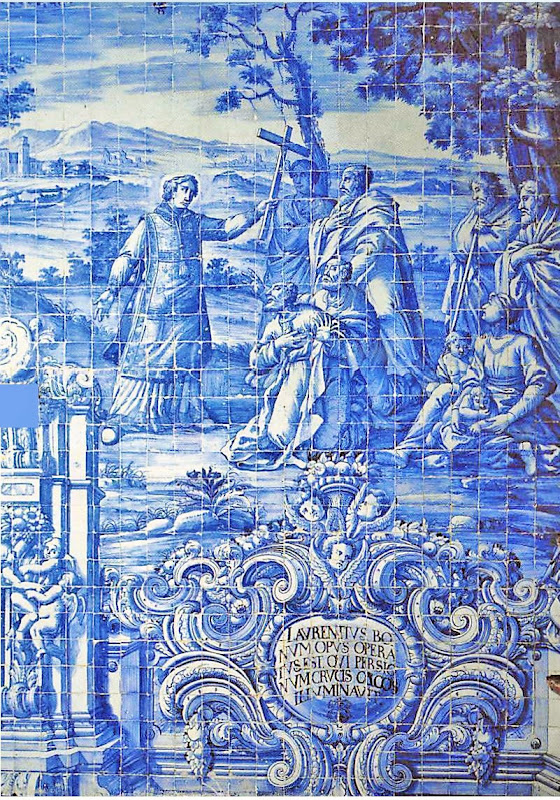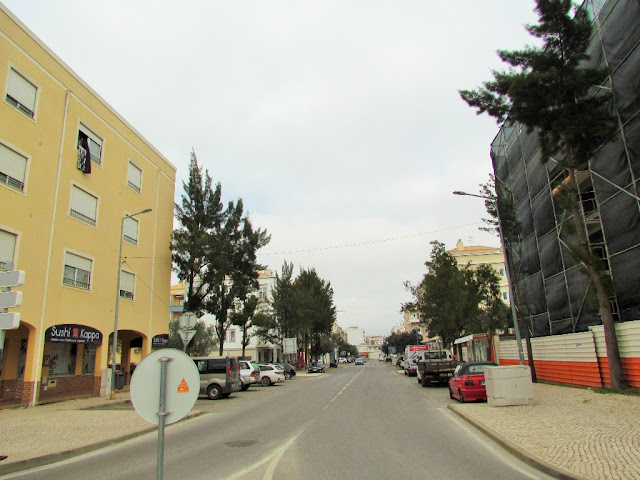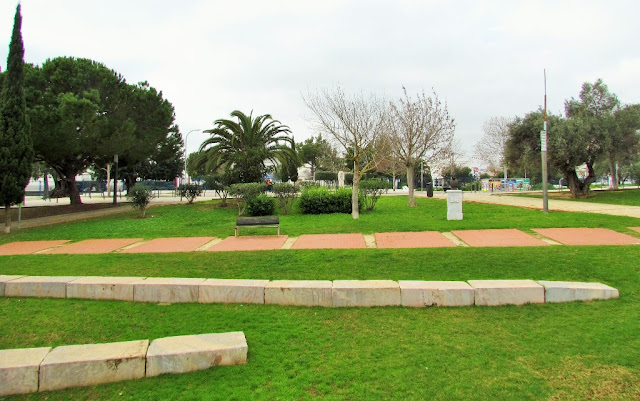Church of São Lourenço
37°4′55.51″N; 8°0′32.19″W
History
The azulejo tile was applied to the church in 1730 by Policarpo de Oliveira Bernardes, from an inscription in the choir. Between 1868 and 1869 a wooden choir was installed, without reusing the existing tile.
Two niches were constructed sometime during the 19th century, destroying some figurative azulejo tile.
In 1984 there was a reconsolidation of the wooden cupola.
Architecture
The church is situated in an urban area, encircled by a churchyard, and accessed by a staircase to the north. It is delimited by an elevated platform over the natural terrain, supported by walls in masonry and mortar. The building and churchyard complex are circled by several small dependencies, which harmoniously form the group, including complimentary azulejo tiles designed by Policarpo de Oliveira Bernardes.
The plan of the church consists of one nave, with rectangular prebystery, lateral chapels, and sacristy in the north. The roofing is differentiated by coverings on the nave, cupola and pinnacles. The principal facade, with minimal decoration, consists of two volumes, with angular corners and a counter-curved frontispiece. A rectangular doorway, surmounted by a window, with lateral pilasters ending in pinnacles, crowned by a fanciful frontispiece and cross.The recessed second volume, is broken by a rectangular door, with a lateral doorway surmounted by the image of Saint Lawrence in stone. The southern lateral face, without decoration, is aligned with the church nave and marked by four small rectangular windows. In the head panel are blue and white azulejos with the image of Saint Lawrence, dating from 1730. The northern facade is marked by a belltower which rises above the sacristy, accessible from a long staircase at the front left of the main facade.
Interior
The barrel-vaulted nave is broken by a cupola, and totally covered in azulejo tile, except for the corners, frames and frames of the windows. These azulejos show scenes from the life of São Lawrence and in each arch, accompanied by his legend in Latin. Lawrence of Rome was martyred in Rome in 258, for challenging Emperor Decius who expected tribute from the church, to which he was deacon. Lawrence distributed the gold to the poor instead, and little reached the Emperor's coffers. Furious, the Emperor ordered the cleric be whipped with rods, then his back seared with burning hot iron, before being extended over a mound of embers (to die). The tiles depict: the saint healing two blind men; the saint giving money to the poor; the saint talking with Pope Sixtus II; the saint arguing for his Christian belief with Roman Emperor Valerian; and the saint's martyrdom.
Over the arches are allegorical figures: Preserverance, Liberty and Poverty, Chastity and Obedience, Piety and Patience, Awe of God and Understanding, and Humility.[1][2] The tiles that cover the cupola following architectural designs with perspectives. Over the window is an inscription: "POLICARPO DE / OLIVEIRA BERN. / PINTOU ESTA OBRA DE AZU / LEIO" (Policarpo de Oliveira Bern. Painted this work of azulejo); in the centre of the vaulted nave is Lawrence in glory, accompanied by angels to his rest, and the caption: "FEITO / NO ANNO DE 1730 / SENDO VIGÁRIO GERAL O R.DO D.TOR M.EL DE SOUZA / TEIXEIRA / JUIS DOSTO" (Done in the year 1730, being the Vicar-General Ricardo Tormel de Sousa Teixeira judge). The extensive azulejo has resulted in it being referred to as the Igreja de Louça (Church of China). In the sacristy cellar are azulejo tiles, with bar and panels in flowering vases. In the nave's papal altar, there are two niches; the chancel with altar marble stone from Alicante and the gilded altarpiece. The baptismal font is also constructed of Alicante stone.
The interior is totally decorated in 17th-century azulejo tiles with scenes from the life of Saint Lawrence, designed by Policarpo de Oliveira Bernardes, which comprised one of the most important groups of azulejo tiles in the country. The complexity is comparable to the azulejo decoration in the presbytery of the Church of São Francisco in Faro, also attributed to this author and the Misercórdia Church in Viana do Castelo, complete by the Policarpo's father (António de Oliveira Bernardes).
ALMANCIL
N 37.08169; W 8.00986
Almancil is a town and freguesia in the Loulé Municipality, in the affluent Golden Triangle region of the Algarve of southern Portugal. Almancil is known for its three Michelin-star restaurants, the most of any town in the Algarve.
The town had a population of 10,677 inhabitants in 2011, in an area of 62.30 square kilometers (24.05 sq mi).
The natural landscape of the parish is marked by the Nature Park of the Ria Formosa, a site of great botanical value and a natural habitat for rare ornithological species. Along the 12-kilometer (7.5 mi) coast are several popular beaches: Ancão, Quinta do Lago, Garrão, and Vale do Lobo.
The economy of Almancil supports the nearby holiday and residential developments: Quinta do Lago and Vale do Lobo. In addition to several tourist-oriented restaurants, real estate offices, supermarkets, flower shops, garden centers, interior decorators and furnishing shops support the local market.
With average land prices starting at €5000 per 1 square meter (1.2 sq yd), Quinta do Lago has the most expensive property rates in Portugal, with the Almancil and Vale do Lobo.
NEW PHOTOS TAKEN IN 2024
💓💓💓💓💓
SEARCH IN ALPHABETICAL ORDER
IN THE DISTRICT OF FARO
💓💓💓💓💓
Return to mainland Portugal &
the Azores and Madeira islands








































































































































































